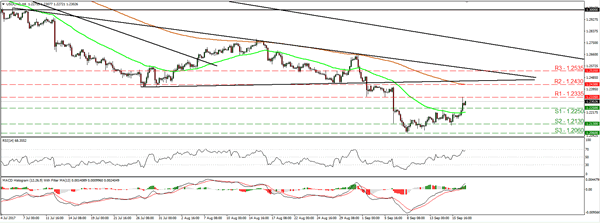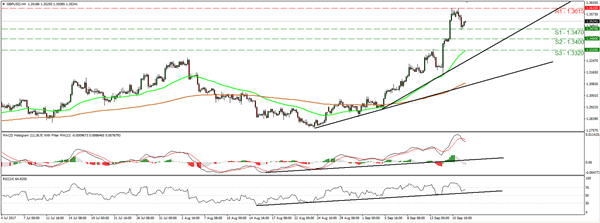Yesterday, BoC policymaker Timothy Lane said they are watching the strengthening CAD closely, and that they will be taking this into account ‘pretty strongly’ in making their decisions. The Loonie dipped immediately on these comments, as it had been a while since the BoC expressed concerns regarding the exchange rate. In our view, there is a decent probability for some similar remarks in the next BoC statement. Governor Poloz could also try to talk down the currency when he speaks on the 27th of September.
Therefore, we see the case for USD/CAD to continue correcting higher over the next few weeks, especially if the FOMC appears somewhat optimistic tomorrow and keeps the prospect of a December rate hike on the table. That said, the pair’s broader trend remains to the downside, amid elevated expectations for another BoC rate hike this year (75% according to Canada’s OIS) and strong Canadian economic data across the board.
USD/CAD edged north yesterday, breaking above the resistance (now turned into support) barrier of 1.2250 (S1) to hit resistance at 1.2335 (R1). Although the rate continues to trade below the prior upside support line drawn from the low of the 26th of July, we see the case for the pair to continue its recovery for a while. A break above 1.2335 (R1) would confirm that and could set the stage for extensions towards our next resistance of 1.2430 (R2).
As for the bigger picture, the price structure on the daily chart remains lower peaks and lower troughs below the downtrend line drawn from the peak of the 5th of May, which keeps the medium-term outlook negative. As such, we would treat the latest recovery, or any extensions of it that stay limited below that trend line, as a corrective phase.
Sterling pulls back as Carney hints at limited rate hikes
Speaking at the IMF yesterday, BoE Governor Mark Carney said that interest rates have to rise a little in order for the level of monetary accommodation to stand still, partly due to the possibility that the global neutral rate of interest may be rising. His comments suggested that one of the reasons the BoE may hike rates is that other major central banks are scaling back stimulus. Overall, he left the impression that any BoE rate increase may be a one-and-done move, as opposed to the beginning of a typical normalization cycle. Even though that shouldn’t come as a surprise given the BoE’s continued signals that any hikes would be gradual and to a limited extent, sterling still corrected lower on Carney’s not-so-hawkish tone.
Despite this correction lower, the outlook for sterling remains positive amid heightened speculation for a near-term rate hike, perhaps as early as at the November meeting when the Bank will also issue fresh economic forecasts. However, we have to reiterate that in our view, UK politics and the lack of progress in the Brexit negotiations remain key risks the market seems to be overlooking at the moment. In particular, the upcoming Conservative Party conference on the 1st of October presents a notable source of uncertainty, as any rebellious attempt to replace PM May could cast a shadow on the latest GBP rally. Indeed, the latest reports of friction between PM May and Foreign Secretary Johnson add credibility to this potential risk.
GBP/USD traded lower after it hit resistance at 1.3615 (R1). Nevertheless, the slide was stopped by the 1.3470 (S1) line and then the pair rebounded somewhat. The price structure on the 4-hour chart remains higher peaks and higher troughs and thus, we still consider the short-term outlook to be positive. We would expect the bulls to take advantage of yesterday’s slide and aim for another test near the 1.3615 (R1) resistance. Having said that though, given the rate’s proximity to the longer-term downside resistance line taken from the peaks of July 2014, we prefer to wait for a clear close above the crossroads of that line and the 1.3615 (R1) zone before we get confident on larger bullish extensions.
Today’s highlights:
During the European day, Germany’s ZEW survey for September is coming out. The current conditions index is expected to have remained more or less unchanged, while the expectations index is forecast to have risen. Although this survey is not usually a major market mover, further improvement in Eurozone’s growth engine may heighten somewhat speculation with regards to a QE exit by the ECB in coming months and thereby, support the common currency a bit. From the US, we get building permits and housing starts, both for August. The nation’s current account balance for Q2 is also coming out. From Canada, we get manufacturing sales for July.
USD/CAD

Support: 1.2250 (S1), 1.2130 (S2), 1.2060 (S3)
Resistance: 1.2335 (R1), 1.2430 (R2), 1.2535 (R3)
GBP/USD

Support: 1.3470 (S1), 1.3400 (S2), 1.3320 (S3)
Resistance: 1.3615 (R1), 1.3825 (R2), 1.4000 (R3)













